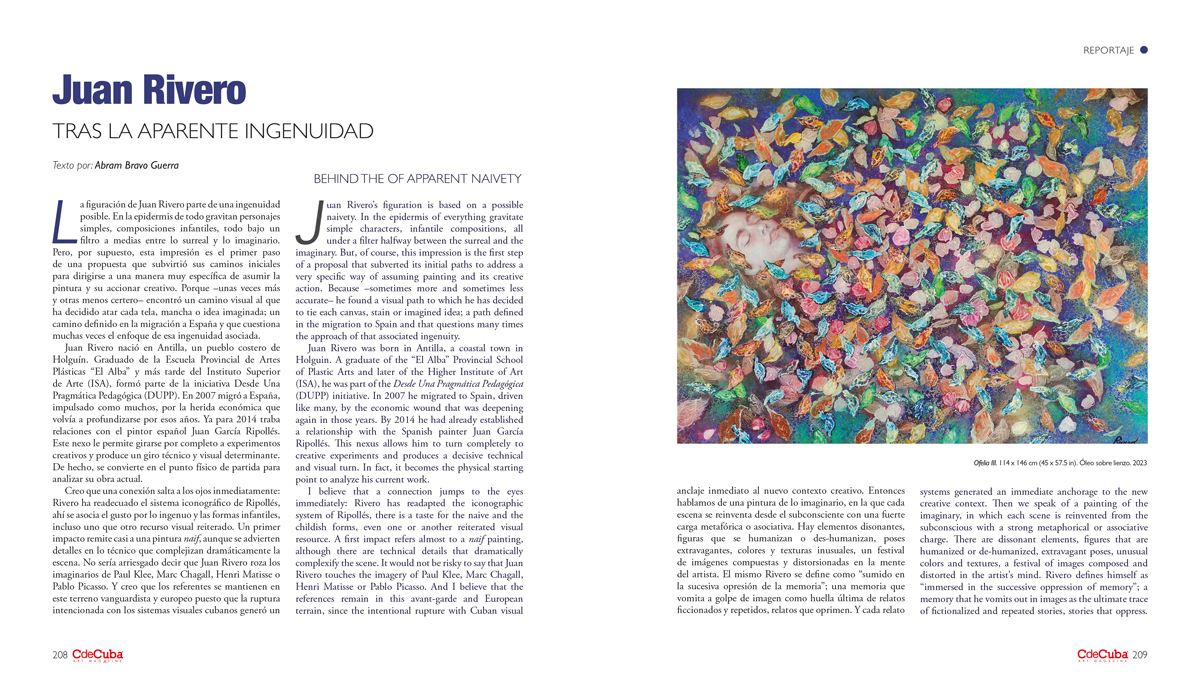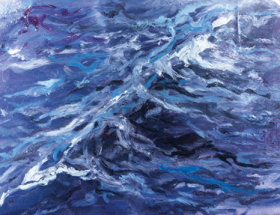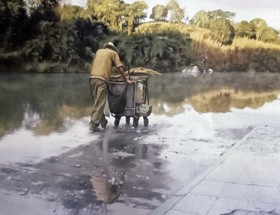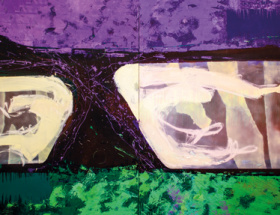Behind the of Apparent Naivety
By Abram Bravo Guerra
Juan Rivero’s figuration is based on a possible naivety. In the epidermis of everything gravitate simple characters, infantile compositions, all under a filter halfway between the surreal and the imaginary. But, of course, this impression is the first step of a proposal that subverted its initial paths to address a very specific way of assuming painting and its creative action. Because –sometimes more and sometimes less accurate– he found a visual path to which he has decided to tie each canvas, stain or imagined idea; a path defined in the migration to Spain and that questions many times the approach of that associated ingenuity.
Juan Rivero was born in Antilla, a coastal town in Holguin. A graduate of the “El Alba” Provincial School of Plastic Arts and later of the Higher Institute of Art (ISA), he was part of the Desde Una Pragmática Pedagógica (DUPP) initiative. In 2007 he migrated to Spain, driven like many, by the economic wound that was deepening again in those years. By 2014 he had already established a relationship with the Spanish painter Juan García Ripollés. This nexus allows him to turn completely to creative experiments and produces a decisive technical and visual turn. In fact, it becomes the physical starting point to analyze his current work.
I believe that a connection jumps to the eyes immediately: Rivero has readapted the iconographic system of Ripollés, there is a taste for the naive and the childish forms, even one or another reiterated visual resource. A first impact refers almost to a naif painting, although there are technical details that dramatically complexify the scene. It would not be risky to say that Juan Rivero touches the imagery of Paul Klee, Marc Chagall, Henri Matisse or Pablo Picasso. And I believe that the references remain in this avant-garde and European terrain, since the intentional rupture with Cuban visual systems generated an immediate anchorage to the new creative context. Then we speak of a painting of the imaginary, in which each scene is reinvented from the subconscious with a strong metaphorical or associative charge. There are dissonant elements, figures that are humanized or de-humanized, extravagant poses, unusual colors and textures, a festival of images composed and distorted in the artist’s mind. Rivero defines himself as “immersed in the successive oppression of memory”; a memory that he vomits out in images as the ultimate trace of fictionalized and repeated stories, stories that oppress. And each story is molded in simplicity and apparent naivety, in a humanoid bestiary without flags, soaked with shameless kitsch and grotesque.
Now, this universe of light forms is conditioned by a particular technical resource. Here, a putty base is applied to the canvas, on which the image is worked, molded and repeated, playing against time. After drying, the remaining layers are lifted off with a jet of pressurized water. In an ironic conjunction of materials, oil, water and a paved and unusually wet canvas end up mixed together. The result ends up being a mark of identity: bright colors, almost iridescent, that (dis)compose a painting full of rough fillings, crevices and deep contours.
But, in this peculiar atmosphere, it is necessary to pay a little more attention to the colors. Those litmus tones are spread in a misty mass that covers almost the entire work, competes in prominence with the image and takes over the spaces that close each scene. The interesting thing lies in the double and opposite sensation produced: vaporous and rough at the same time. When Rivero dispenses with color, the same finish ends up filling in the gaps in grayish measures, now renouncing the strident oranges or the uncomfortable pinks. Instead, the drawing blends with that vaporous sensation of weightlessness or rejects it in an abrupt material solidity: modulated from the putty, the figures are sometimes delineated in pronounced grooves, finished off in black borders or violent indentations that wound bodies and objects. And, in a certain indecision, the bodies deform, stretch, compress and twist, they go from sensitive figurines to disturbing images according to the scene, the pose, or the impression of each one, according to the theme. So this –the theme– becomes another important component in his figuration.
The thing is that Rivero allows himself to play on opposite sides depending on what he represents and how he does it. He deploys a gallery of controversial characters, set up for dialogue and who shatter the line of calm with unexpected ease. Although much more conservative situations are also repeated in his work, Rivero outrages the calm with the sickening reiteration of a menacing dog, with deliberate sex scenes, or with those groups of dwarfs that twist and vomit like little devils. There is a clear note of sordidness where his pictorial proposal sounds the loudest. The more grotesque, he allows himself experiments that challenge the possible limitations of the putty, even of the visual body itself that his work could suggest. The results are reversed in more dynamic compositions, bold and making use of sensory contrast and the suppression of conventions.
Let’s say that Rivero, at the end of the day, achieves more the more of himself he draws. The line of his work seems to become clearer as he challenges the conventions associated with that naiveté, that painting of a child’s face. Because both notions collapse from the rigorous process of invoice and, in the background, in thematic approaches that, although they are not strange to naif painting, would hardly fit in the paintings of Klee, Chagall or Matisse. And, mediating in a visuality at least complex to handle, he has managed to land on a personal way of painting, mutable and improvable as it transforms according to the subject. I think I see an exploration in process, still immature, but fully convinced of its potential, of that which is beyond naivety.






